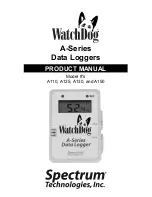
Table
8-1:
CRVW3
LED
behavio
ur
RX/TX LED (left side)
1
Status LED (right side)
Solid red
Radio error
Solid red
Measurement or program error
Solid green
Measuring sensor(s)
Solid orange
Radio configuration, system is
busy and no communications
will occur. Allow up to 20
seconds before attempting to
connect.
Solid orange
Device or OS configuration,
system is busy and no
communications will occur.
Flashing red
Radio transmit (TX)
Flashing red
No measurements possible with
only USB power.
(For –RF451/RF452 option, radio
is not powered. No
communications possible.)
Flashing
green
Radio receive (RX)
Flashing
green
Awake (heartbeat)
Flashing
orange
No carrier detect (RF451/RF452
radio only)
Flashing
orange
Awake (heartbeat); in repeater
mode for –RF451/RF452 option
Off
No radio activity
Off
Device idle or turned off
1
Only applicable to CRVW3-RF models
8.2 Connecting sensors to the CRVW3
Install the vibrating-wire sensors according to manufacturer supplied instructions. A 5-wire or 3-
wire cable will connect between each sensor and the CRVW3. Vibrating-wire sensors containing a
built-in thermistor will have five wires. Sensors without a built-in thermistor will have three wires.
A sensor with five wires will have two wires for the coil circuit, two wires for the thermistor, and a
shield wire. A 3-wire sensor has two wires for the coil circuit and a shield wire.
Cable distances more than 500 m (1500 ft) may require the use of 12 VDC excitation instead of
5 VDC excitation. See Excitation voltage in
(p. 21). 12 VDC excitation uses
more power which will reduce battery power more quickly than 5 VDC. Vibrating-wire sensor
connections can provide reliable readings using cable distances up to 1500 m (4500 ft) in some
circumstances. However, cable distances less than 500 m (1500 ft) are recommended. Up to three
vibrating-wire sensors can be connected to each CRVW3.
CRVW3 3-Channel Vibrating-Wire Data Logger
40













































